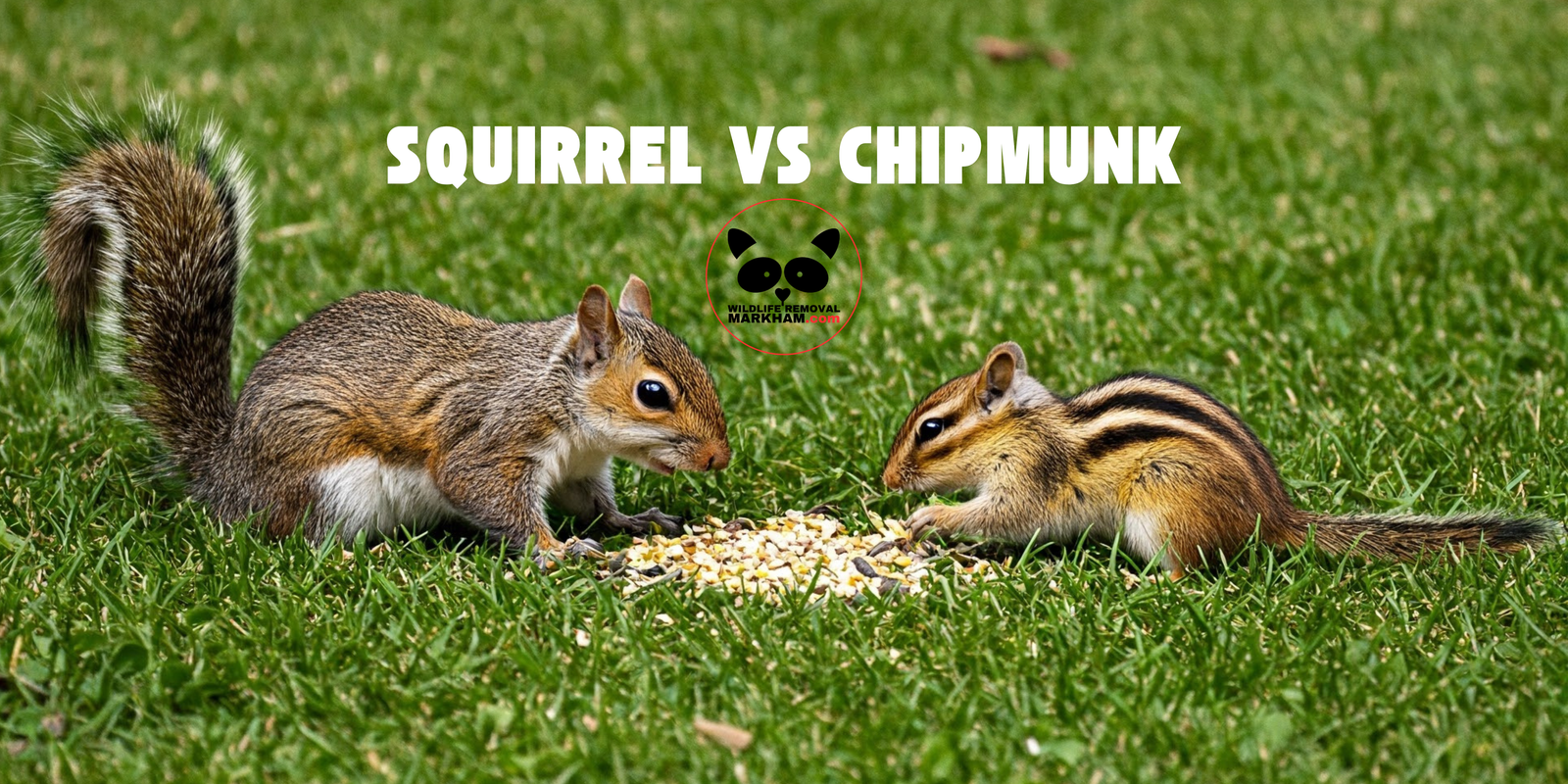Introduction
Squirrels and chipmunks are both Sciuridae family members, so they’re closely related but they are from different species. While they share similar behaviours, they differ in appearance, habitat and lifestyle. Understanding these little critters will help homeowners and nature lovers coexist with them in wooded areas and urban spaces.
Physical Characteristics


Size and Appearance – Eastern Gray Squirrel vs. Chipmunk (Tamias Minimus)
Squirrels and chipmunks may appear similar at first glance, but they have distinct physical differences. It’s easy to differentiate the two – they are not the same size, squirrels are larger, they typically have bushy tails, while chipmunks are small, have sleeker, less fluffy tails. Chipmunks are easily recognized by the dark stripes running along their backs, whereas squirrels have a more uniform colour. These features help differentiate the two species in the wild.
Fur and Colouration
Squirrels come in many colours, rusty-orange Eastern fox squirrels, silver-gray Eastern Gray squirrel, deep brown Western Gray squirrel. Red squirrels are territorial and aggressive towards chipmunks. The Eastern chipmunk and Siberian chipmunk have a dark stripe on their back and tail which help them blend in. Their fur changes slightly with the seasons for better insulation for these animals in the cold weather.
Vocal Sounds
A chipmunk makes chirping sounds, while a squirrel produces clicking noises and flicks its tail to alert her family and other nearby squirrels of danger or distress.
Habitat and Nesting
Where Tree Squirrels Live
Squirrels and chipmunks live in different habitats depending on the species. Tree squirrels live in trees, in parks, forests and attics. Ground squirrels, marmots, and prairie dogs dig burrows in loose dirt, they build underground tunnels for shelter usually disappearing until late winter is over. Both live in natural and urban areas.
Squirrel Nests and Nesting Habits
Squirrels build nests in trees using twigs and leaves. Chipmunks live underground, they dig elaborate burrow systems with multiple entrances to avoid predators like snakes and hawks. Squirrels sometimes take shelter in human structures leading to infestations in attics and other hidden spaces. When this happens, reach out to a professional and affordable wildlife control company that can come and humanely remove the squirrels and/or a family of babies that might be inside.
Diet and Foraging Behaviour for Squirrels and Chipmunks
What They Eat
Chipmunks are considered omnivores and squirrels are technically considered herbivores. Chipmunks will eat insects, snails, small birds, frogs, seeds and berries, whereas a squirrel mainly eats nuts, acorns, seeds, fungi, fruits, and vegetables. Squirrels would eat bugs or insects as a last resort but it is not a primary part of their diet. This diet changes with the seasons as they prepare for the long winter by gathering extra food. They collect nuts, acorns and other plant materials for survival.
Foraging and Food Storage
Squirrels and chipmunks have different food storage methods. Squirrels bury nuts and seeds in various spots and rely on memory to retrieve it later, or they’ll store their food in an attic space or den (cache). Chipmunks use their cheek pouches to carry large amounts of food back to their burrows underground. Both are seed dispersers and help trees grow in new areas.
Behaviour and Activity of These Rodents
Movement and Climbing Trees
Squirrels are great at climbing trees using their sharp claws and strong limbs. Flying squirrels can glide between trees, chipmunks stay closer to the ground. Despite their size, these small animals are fast on the ground and can escape danger by darting into burrows.
Interaction with Humans, Bird Feeders and Other Wildlife
Squirrels and chipmunks interact with humans often, raiding bird feeders or garbage cans for an easy meal. Some homeowners see them as critters that cause damage, especially when they chew on structures or nest in an attic. They must also navigate threats from predators, birds, foxes and larger mammals.
Seasonal Adaptations and Hibernation
Chipmunks prepare for winter by storing food in their burrows where they sometimes enter a state of torpor, they don’t truly hibernate but they do sleep quite a bit and periodically come out . Nearby, squirrels remain active during the colder months and rely on stored food to survive. Their thick fur and bushy tail helps them stay warm in harsh conditions.
Conclusion
Squirrels and chipmunks may be related but they have many differences in appearance, behaviour and habitat. Whether they are burrowing underground or climbing high into the trees these animals play a vital role in the ecosystem. Understanding their habits will help us appreciate their presence in nature while managing their impact on our spaces.



